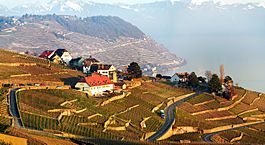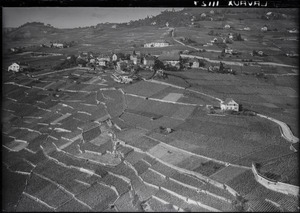Grandvaux facts for kids
Quick facts for kids
Grandvaux
|
||
|---|---|---|
 |
||
|
||
| Country | Switzerland | |
| Canton | Vaud | |
| District | Lavaux-Oron | |
| Area | ||
| • Total | 2.94 km2 (1.14 sq mi) | |
| Elevation | 489 m (1,604 ft) | |
| Population | ||
| • Total | 2,014 | |
| • Density | 685.0/km2 (1,774/sq mi) | |
| Demonym(s) | Les Grandvaliens | |
| Postal code |
1091
|
|
| Surrounded by | Cully, Forel (Lavaux), Meillerie (FR-74), Villette (Lavaux) | |
Grandvaux was once a small town, or municipality, in Switzerland. It was located in the canton of Vaud, within the Lavaux-Oron area.
On July 1, 2011, Grandvaux joined with several other towns. These were Cully, Epesses, Riex, and Villette (Lavaux). Together, they formed a new, larger municipality called Bourg-en-Lavaux.
Contents
- A Look Back: Grandvaux's History
- Exploring Grandvaux: Geography and Landscape
- Grandvaux's Symbol: The Coat of Arms
- Who Lives There: Grandvaux's Population
- Important Places: Heritage Sites
- Working in Grandvaux: The Economy
- Beliefs in Grandvaux: Religion
- Learning in Grandvaux: Education
- Friends Around the World: Sister Cities
- See also
A Look Back: Grandvaux's History
Grandvaux is quite old! People first wrote about it in the year 1250. Back then, it was known by a slightly different name, de Gravaz. Later, in 1445, it was called Grandvaulx.
Exploring Grandvaux: Geography and Landscape
Grandvaux covers an area of about 2.94 square kilometers (which is about 1.14 square miles). A big part of this land, more than half, is used for farming. About 10% of the area is covered by forests. The rest, around 35%, has buildings and roads.
Most of the built-up areas are homes and other buildings. Roads and other ways to get around make up a smaller part. The forests in Grandvaux are mostly thick, natural woods. For farming, people grow crops, use land for pastures, and have many orchards or vineyards.
Grandvaux is located right on the beautiful shores of Lake Geneva. From the lake, the land rises up to a hill called Signal de Grandvaux, which is 795 meters (about 2,608 feet) high. The area includes the main village of Grandvaux, some smaller neighborhoods called hamlets like Curson, and even some woods in the Jorat region.
Grandvaux's Symbol: The Coat of Arms
Every town has a special symbol, called a coat of arms. Grandvaux's coat of arms is quite simple but meaningful. It shows a red background with a silver orb, which looks like a globe or a ball.
Who Lives There: Grandvaux's Population
In 2009, Grandvaux had a population of 2,014 people. About 19% of the people living there were from other countries. Over the ten years before 2009, the number of people in Grandvaux grew by about 4.4%. This growth happened because more people moved in and more babies were born than people who passed away.
Most people in Grandvaux speak French, which is the main language. A smaller number of people speak German, and even fewer speak English.
Many people living in Grandvaux were born there or in the same canton (state) of Vaud. About 22% of the people were born outside of Switzerland.
In 2009, the population of Grandvaux included many young people. About 9.7% were children under 9 years old, and 11.3% were teenagers between 10 and 19. Adults made up the largest part of the population, with many people in their 30s, 40s, and 50s. There were also a good number of seniors, including those over 90 years old.
The chart below shows how Grandvaux's population has changed over many years:

Important Places: Heritage Sites
Grandvaux is home to some very important historical sites. The Maison Maillardo, a special old house, is listed as a Swiss heritage site of national significance. This means it's super important to Switzerland's history and culture.
Also, a part of the famous UNESCO World Heritage Site called Lavaux, Vineyard Terraces, is in Grandvaux. These terraces are ancient vineyards built on hillsides, showing amazing human effort and history. The entire village of Grandvaux is also part of the Inventory of Swiss Heritage Sites, meaning the whole town is considered historically valuable.
The Maison Maillardo is especially famous for its windows. They were built in the 16th century in a style called late-gothic.
Working in Grandvaux: The Economy
In 2010, Grandvaux had a low unemployment rate, meaning most people who wanted jobs had them. Many people worked in different areas:
- Primary sector: This includes jobs like farming. About 71 people worked in this area.
- Secondary sector: This includes jobs like manufacturing (making things) and construction (building things). About 60 people worked here.
- Tertiary sector: This includes jobs that provide services, like sales, hotels, restaurants, healthcare, and education. About 203 people worked in this sector.
In 2008, there were 263 full-time jobs in Grandvaux. Many of these jobs were in agriculture, construction, and services. For example, many people worked in sales, hotels, restaurants, and healthcare.
Most people who lived in Grandvaux actually traveled to other towns for work. Only a smaller number of people came into Grandvaux to work. About 11% of workers used public transportation, like buses or trains, to get to work. A much larger number, about 71%, used their own cars.
Beliefs in Grandvaux: Religion
In 2000, many people in Grandvaux belonged to a Christian church. About 29% were Roman Catholic, and about 47% belonged to the Swiss Reformed Church. Some people belonged to other Christian churches.
A small number of people were Islamic or Jewish. About 16% of the population said they didn't belong to any church or were agnostic or atheist.
Learning in Grandvaux: Education
Education is important in Grandvaux. Many adults, about 35%, have finished high school. Even more, about 27%, have gone on to higher education, like a university or a specialized college.
In the 2009/2010 school year, Grandvaux had 205 students in its school district. The canton (state) of Vaud offers two years of optional pre-school. Many children in the area received this pre-school care.
Students in Grandvaux attended primary school for four years. After that, they went to lower secondary school for six years.
In 2000, some students from other towns came to Grandvaux for school. However, more students from Grandvaux went to schools outside the municipality.
Friends Around the World: Sister Cities
Grandvaux used to have a special friendship with a town far away! It was a "sister city" with Nagara Furusato in Tōno, Iwate, Japan.
See also
 In Spanish: Grandvaux (Vaud) para niños
In Spanish: Grandvaux (Vaud) para niños





